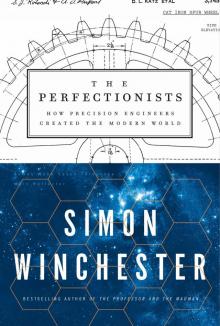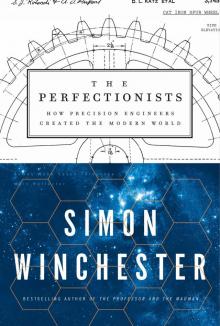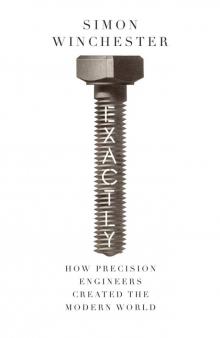- Home
- Simon Winchester
The Perfectionists: How Precision Engineers Created the Modern World Page 3
The Perfectionists: How Precision Engineers Created the Modern World Read online
Page 3
A shoe, for instance, is invariably a thing of very low tolerance: on the one hand, a poorly made slipper may have “an agreed or stated amount of allowable variation in its dimensions” (which is the engineer’s formal definition of tolerance) of half an inch, with so generous an amount of wiggle room between foot and lining as to make the notion of precision almost irrelevant. A handmade brogue shoe by Lobb of London, on the other hand (or foot), may seem to fit snugly, perfectly, precisely even, but it will still have a tolerance of maybe an eighth of an inch—and in a shoe, such a tolerance would be acceptable, and the shoe indeed worn with pride. Yet, in terms of precision engineering, it is anything but precisely made; nor is it even accurately so.*
ONE OF THE two most precise measuring instruments ever built by human agency stands in America’s Pacific Northwest, far away from everything, in the arid middle of Washington State. It was built just outside the top-secret nuclear installation where the United States created the first supplies of plutonium for the bomb that destroyed Nagasaki, for decades the material at the heart of much of the nation’s arsenal of atomic weapons.
The years of nuclear activity there have left an unimaginably large legacy of dangerously irradiated substances, from old fuel rods to contaminated items of clothing, which are only now, and after a loud public outcry, being remedied—or remediated, the term environmentalists prefer. Today, the Hanford site, as it is known, is officially the largest environmental cleanup site in the world, with decontamination bills reaching the tens of billions of dollars and the necessary remedial work likely to last until the middle of the twenty-first century.
I first passed by the site very late one night, after a long drive from Seattle. From my southbound speeding car, I could see the glimmer of lights in the far distance. Behind razor-wire security fences and warning signs and under the protection of armed guards, some eleven thousand workers are now laboring night and day to cleanse the earth and waters of the poisonous radioactivity that so dangerously suffuses it. Some suppose it is a task so vast that it may never be properly completed.
To the south of the main cleanup site, just outside the razor-wire fence but within sight of the still-standing towers of the remaining atomic piles, one of present-day science’s most remarkable experiments is being conducted. It is not secret at all, is unlikely to leave a legacy of any danger whatsoever, and requires the making and employment of an array of the most precise machines and instruments that humankind has ever attempted to construct.
It is an unassuming place, easily missed. I arrived for my appointment in morning daylight, weary after the long nighttime drive. It was cold; the road was quite empty, the main turnoff unmarked. A small notice on the left pointed to a cluster of low white buildings a hundred yards off the road. “LIGO,” the sign read. “WELCOME.” And that was about all. Welcome to the current cathedral, it might also have said, to the worship of ultraprecision.
It has taken decades to design the scientific instruments that are secreted out in the middle of this dust-dry nowhere. “We maintain our security by our obscurity” is the motto for those who fret about the costly experiments sited there, all without a fragment of barbed wire or chain link to protect them. The tolerances of the machines at the LIGO site are almost unimaginably huge, and the consequent precision of its components is of a level and nature neither known nor achieved anywhere else on Earth.
LIGO is an observatory, the Laser Interferometer Gravitational-Wave Observatory. The purpose of this extraordinarily sensitive, complex, and costly piece of equipment is to try to detect the passage through the fabric of space-time of those brief disruptions and distortions and ripples known as gravitational waves, phenomena that in 1916 Albert Einstein predicted, as part of his general theory of relativity, should occur.
If Einstein was right, then once every so often, when huge events occur far out in deep space (the collision of a pair of black holes, for instance), the spreading fan of interstellar ripples, all moving at the speed of light, should eventually hit and pass through the Earth and, in doing so, cause the entire planet to change shape, by an infinitesimal amount and for just the briefest moment of time.
No sentient being would ever feel such a thing; and the slight squeezing would be so minute and momentary and harmless that not a trace could ever be recorded by any machine or device known—except, in theory, by LIGO. And after decades of experiments with instruments that were being ever more refined to greater and greater degrees of sensitivity, the devices now running in the high northwest desert of Washington State and down in the bayous of Louisiana, where the second such observatory has been built, have indeed brought home the bacon.
For, in September 2015, almost a century after Einstein’s theory was first published, and then again on Christmas Eve that same year and then again in 2016, LIGO’s instruments showed without doubt that a series of gravitational waves, arriving after billions of years of travel from the universe’s outer edges, had passed by and through Earth and, for the fleeting moment of their passage, changed our planet’s shape.
TO DETECT THIS, the LIGO machines had to be constructed to standards of mechanical perfection that only a few years before were well-nigh inconceivable and that, before then, were neither imaginable nor even achievable. For it was not always so, this delicacy, this sensitivity, this ultraprecise manner of doing things. Precision was not always there, waiting in the shadows, needing to be found and then exploited for what its early admirers believed would be the common good. Far from it.
Precision was a concept that was invented, quite deliberately, out of a single and well-recognized historic need. It was brought into being for severely practical reasons—reasons that had much to do not with any dreamy twenty-first-century wish to confirm (or otherwise) the existence of vibrations from the collisions of distant stars. Rather, it had to do with a down-to-earth eighteenth-century realization of what was then a pressing matter of physics, and which was related to the potentially awesome power of that high-temperature form of water that since the century before had been known as and defined by the word steam.
Precision’s birth derives from the then-imagined possibility of maybe holding and managing and directing this steam, this invisible gaseous form of boiling water, so as to create power from it, and to demand that by the employment of this power, it perform useful work for the good (perhaps, and with luck) of all humankind.
And all that, what turned out to be one of the most singular of engineering epiphanies, took place in North Wales on a cool May day in 1776—by coincidence, within weeks of the founding of the United States of America, which would eventually make such use of the precision techniques that duly evolved.
That spring day is now generally (though not unanimously) agreed to mark the birth date for the making of the first construction possessed of a degree of real and reproducible mechanical precision—precision that was measurable, recordable, repeatable, and, in this case, created to the tolerance of one-tenth of an inch, or, as it was put at the time, of an English silver coin with a value or worth of just one shilling.
Chapter 1
(TOLERANCE: 0.1)
Stars, Seconds, Cylinders, and Steam
It is the mark of an instructed mind to rest assured with that degree of precision that the nature of the subject admits, and not to seek exactness when only an approximation of the truth is possible.
—ARISTOTLE (384–322 BC), NICOMACHEAN ETHICS
The man who by the common consent of the engineering fraternity is regarded as the father of true precision was an eighteenth-century Englishman named John Wilkinson, who was denounced sardonically as lovably mad, and especially so because of his passion for and obsession with metallic iron. He made an iron boat, worked at an iron desk, built an iron pulpit, ordered that he be buried in an iron coffin, which he kept in his workshop (and out of which he would jump to amuse his comely female visitors), and is memorialized by an iron pillar he had erected in advance of his passing in a remote village i
n south Lancashire.
Still, a case can also be made that “Iron-Mad Wilkinson,” as he was widely known, had predecessors who can lay near-equal claim to parenthood. One of them was a luckless clockmaker from Yorkshire named John Harrison, who worked just a few decades earlier to create devices that kept near-perfect time; the other, rather unexpectedly to those who suppose precision to be more or less a modern creation, was a nameless craftsman who worked in Ancient Greece some two thousand years before Harrison, and whose triumph of precise craftsmanship was discovered deep in the Mediterranean at the turn of the last century by a group of fishermen out diving for sponges.
The Greek team, diving in the warm waters south of the Peloponnese, close to the small island of Antikythera, found sponges in abundance, as they usually did. Yet this time they found something else: the spars and tumbled beams of a wrecked ship, most probably a Roman-era cargo vessel. Among all the broken wood, they came upon a diver’s dream: a massive trove of marvels of art and luxury, along with, more mysteriously, a telephone directory–size lump of corroded and calcified bronze and wood that was initially discounted and almost discarded as being of little archaeological significance.
Except that after sitting for two years in a drawer in Athens, overlooked and yet all the while patiently drying itself out, the sorry-looking lump fell apart. It sundered itself into three pieces, revealing within, and to the astonishment of all, a mess of more than thirty metallic and cleverly meshing gearwheels. One of these wheels had a diameter almost as wide as the object itself; others were no wider than a centimeter. All had hand-cut triangular teeth—the tiniest wheels had as few as 15; the enormous one had a then-inexplicable 223. It looked as though all the wheels had been cut from a single plate of bronze.
Astonishment at this discovery quickly turned to disbelief, to skepticism, to a kind of puzzled fearfulness among scientists who simply could not believe that even the most sophisticated of Hellenistic engineers had ever been capable of making such a thing. So, for almost half a century, this most intimidating machine—if that is what it was—was locked away again, secured and contained like a deadly pathogen. It was given a name, the Antikythera mechanism, for the island, halfway between Crete and the southern tendrils of mainland Greece, off which it was found. It was then quietly and casually all but erased from a Greek archaeological history that was much more comfortable dealing with the more customary fare of vases and jewelry, amphorae and coins, and statues of marble or the most lustrous bronze. A handful of slim books and pamphlets were published, declaring the device to be some kind of astrolabe or planetarium, but otherwise, there was a near-universal lack of interest in the find.
It was not until 1951 that Derek Price, a young British student of the history and social impact of science, won permission to take a closer look at the Antikythera mechanism, and for the next two decades he subjected the shattered relic, with a total of now more than eighty additionally found bits and pieces as well as the three main fragments, to blizzards of X-rays and wafts of gamma radiation, probing secrets that had been hidden for two thousand years. Eventually, Price decided the work was much more complex and important than a mere astrolabe—it was in fact more likely to be the once-beating heart of a mysterious computing device of unimagined mechanical complexity, one that had evidently been made in the second century BC and was clearly a work of staggering genius.
Price’s work in the 1950s was limited by his technology’s inability properly to peer inside the device. All this changed with the invention twenty years later of magnetic resonance imaging, or MRI, which led in 2006, more than a century after the sponge seekers made their first find, to the publication in Nature of a profoundly more detailed and sophisticated analysis.
The world-scattered team of specialist researchers who produced the Nature article concluded that what the Greek divers had pulled to the surface were the remains of a miniaturized and neatly boxed mechanical device, an analog computer, essentially, with dials and pointers and rudimentary instructions for how to use it. It was a device that “calculated and displayed celestial information, particularly cycles such as the phases of the moon and a luni-solar calendar.” Moreover, minuscule inscribed lettering in Corinthian Greek chased into the machine’s brass work—a total of 3,400 letters, all millimeter-size, have been found thus far—suggested that the gearwheels, once fully engaged with one another with the turning of a crank on the side of the box, could also predict the movement of the five other planets then known to the Ancient Greeks.*
Enthusiasts, a small but fervent corps of devotees of this extraordinary little instrument, have since built working models of the mechanism, in wood and brass and, in one instance, with its bronze innards expanded and exploded as in a 3-D checkers game, between layers of transparent Perspex. It was the numbers of teeth on the various wheels that offered the first clues as to how they might have been employed by the machine’s makers. The fact that there were 223 teeth on the largest of the gearwheels, for example, provided a eureka moment for the investigators, who remembered that Babylonian astronomers, who were the most astonishingly able watchers of the skies, had calculated that lunar eclipses were usually separated by 223 full moons. Use of this particular wheel, then, would have enabled the user to predict the timing of eclipses of the moon (just as other wheels and combinations of wheels would have turned pointers on dials to display phases and planetary perturbations) and the dates, more trivially, of upcoming public sporting events, most notably the ancient Olympic Games.
Modern investigators have concluded that the device was very well made, “with some parts constructed to accuracies of a few tenths of a millimeter.” By that measure alone, it would seem that the Antikythera mechanism can lay claim to being a most precise instrument—and, crucially for this introduction to the story, maybe the first precision instrument ever made.
Except that there is an inherent flaw in this claim. The device, as model-tested by the legions of fascinated modern analysts, turns out to be woefully, shamefully, uselessly inaccurate. One of the pointers, which supposedly indicates the position of Mars, is on many occasions thirty-eight degrees out of true. Alexander Jones, the New York University antiquities professor who has perhaps written most extensively about the Antikythera mechanism, speaks of its sophistication as being that only “of a young and rapidly developing craft tradition,” and of “questionable design choices” by its makers, who, in summary, produced a device that was “a remarkable creation, but not a miracle of perfection.”
There is one additional puzzling aspect of the mechanism that still intrigues historians of science to this day: while it was filled to bursting with what is self-evidently a complicated assemblage of clockwork, none of its assemblers apparently ever thought of using it as a clock.
Hindsight permits us to be puzzled, of course, and persuades us to want to reach back to the Greeks and shake them a little for ignoring what to us seems obvious. For time was already being measured in Ancient Greece with the help of all manner of other devices, most popularly with sundials, dripping water, hourglasses (as in egg timers), oil lamps with time-graduated fuel holders, and slow-burning candles with time graduations on the stick. And though the Greeks possessed (as we now know from the existence of the mechanism) the wherewithal to harness clockwork gears and make them into timekeepers, they never did so. The penny never dropped. It never dropped for the Greeks or, subsequently, for the Arabs or, even beforehand, for the much more venerable civilizations of the East. It would take many more centuries for mechanical clocks to be invented anywhere, but once they were, they would have precision as their most essential component.
Though the eventual function of the mechanical clock, brought into being by a variety of claimants during the fourteenth century, was to display the hours and minutes of the passing days, it remains one of the eccentricities of the period (from our current viewpoint, that is) that time itself first played in these mechanisms a somewhat subordinate role. In their earliest medieval inc
arnations, clockwork clocks, through their employment of complex Antikythera-style gear trains and florid and beautifully crafted decorations and dials, displayed astronomical information at least as an equal to the presentation of time. It was almost as though the passage of celestial bodies across the heavens was considered more significant than the restless ticking of the passage of moments, of that one-way arrow of time that Newton so famously called “duration.”
There was a reason for this. Nature’s offerings of dawn, midday, and dusk already provided the temporal framework—the mundane business of when it was time to rise and work, when came the time to rest, to mop the brow and take a drink, and when the time to take nourishment and prepare for sleep. The more finicky details of time (a man-made matter, after all), of whether it was 6:15 a.m. or ten minutes to midnight, were necessarily of lesser importance. The behavior of the heavenly bodies was ordained by gods, and therefore was a matter of spiritual significance. As such, it was far worthier of human consideration than our numerical constructions of hours and minutes, and was thus more amply deserving of flamboyant mechanical display.
Eventually, though, the reputation and standing of the hours and minutes themselves did manage to rise through the ranks, did come to dominate the usage of the clockwork mechanisms that became known, generically, as timekeepers. The Ancients may have looked upward to the skies to gather what time it was, but once machinery began to perform the same task, a vast range of devices took over the duty, and has done so ever since.

 The Surgeon of Crowthorne
The Surgeon of Crowthorne Korea: A Walk Through the Land of Miracles
Korea: A Walk Through the Land of Miracles The Men Who United the States: America's Explorers
The Men Who United the States: America's Explorers Outposts: Journeys to the Surviving Relics of the British Empire
Outposts: Journeys to the Surviving Relics of the British Empire Atlantic: Great Sea Battles, Heroic Discoveries, Titanic Storms
Atlantic: Great Sea Battles, Heroic Discoveries, Titanic Storms The Professor and the Madman: A Tale of Murder, Insanity
The Professor and the Madman: A Tale of Murder, Insanity A Crack in the Edge of the World
A Crack in the Edge of the World The Perfectionists: How Precision Engineers Created the Modern World
The Perfectionists: How Precision Engineers Created the Modern World The Man Who Loved China: The Fantastic Story of the Eccentric Scientist
The Man Who Loved China: The Fantastic Story of the Eccentric Scientist The River at the Center of the World: A Journey Up the Yangtze
The River at the Center of the World: A Journey Up the Yangtze The Fracture Zone: My Return to the Balkans
The Fracture Zone: My Return to the Balkans The Map That Changed the World
The Map That Changed the World Krakatoa: The Day the World Exploded
Krakatoa: The Day the World Exploded The Man Who Loved China
The Man Who Loved China The River at the Centre of the World
The River at the Centre of the World Bomb, Book and Compass
Bomb, Book and Compass The Perfectionists
The Perfectionists The Meaning of Everything
The Meaning of Everything Exactly
Exactly Atlantic
Atlantic Korea
Korea The Fracture Zone
The Fracture Zone Pacific
Pacific Krakatoa
Krakatoa The Professor and the Madman
The Professor and the Madman Outposts
Outposts